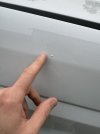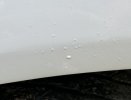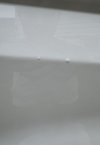Joshbot007
Promoted Users
Here is the background: my truck I am restoring and doing a color change on to bring up to standard. Stripped to metal using rotary sander, solvent borne wgr followed by waterborne, 2 wet coats spi epoxy, body filler (however on this problem panel no filler was applied as it was new), another 1:1 epoxy coat, epoxy seal coat, motobase base coat, 3 wet euro clear coats. Compressor setup is a 60gal with 55ft copper pipe to dry, filter, desiccant dryer, and disposable filter at the inlet of the gun (changed out after every 3 coats). Each coat was applied to the whole truck at once
Whats happened: been 2.5 weeks since spraying and I am noticing bubbles coming up on the passenger fender which was brand new. I also did find one very small bubble on the back of the cab but I'm ignoring that for now as it could be a dust nib, it’s very small while the passenger fender has a ton of them with a few big ones. Sun has been non existent here in PA since the day I sprayed it and had to move it out into the overcast and rain 4 days after spraying.
Any idea on what’s going on? Only thing I can think of is the new fender had an edip coating on it that I took off (probably 99% some trace amounts may have remained), wondering if they do an acid treatment before edip and that’s causing my problems?
Also any suggestions on how to stop it, or prevent it from getting worse such as deflating the bubbles and using a pin and putting touch up clear on or something? Leaving it as is and hope they stop growing? Its a work truck so just want to make the job last not as concerned about looks at this point just want to stop it where its at and prevent it from getting worse and causing major delam. Could potentially respray in the spring but not an option until then due to time and my “booth” getting too cold. Today is the first day of partial sunlight and I moved the truck to face that panel towards the sun to try to help it start drive solvents out hoping that will help. At this point just getting scared the rest of the truck is soon to follow and anything I can do (if anything at all) to prevent it I want to do asap.
Whats happened: been 2.5 weeks since spraying and I am noticing bubbles coming up on the passenger fender which was brand new. I also did find one very small bubble on the back of the cab but I'm ignoring that for now as it could be a dust nib, it’s very small while the passenger fender has a ton of them with a few big ones. Sun has been non existent here in PA since the day I sprayed it and had to move it out into the overcast and rain 4 days after spraying.
Any idea on what’s going on? Only thing I can think of is the new fender had an edip coating on it that I took off (probably 99% some trace amounts may have remained), wondering if they do an acid treatment before edip and that’s causing my problems?
Also any suggestions on how to stop it, or prevent it from getting worse such as deflating the bubbles and using a pin and putting touch up clear on or something? Leaving it as is and hope they stop growing? Its a work truck so just want to make the job last not as concerned about looks at this point just want to stop it where its at and prevent it from getting worse and causing major delam. Could potentially respray in the spring but not an option until then due to time and my “booth” getting too cold. Today is the first day of partial sunlight and I moved the truck to face that panel towards the sun to try to help it start drive solvents out hoping that will help. At this point just getting scared the rest of the truck is soon to follow and anything I can do (if anything at all) to prevent it I want to do asap.
Attachments
Last edited:



